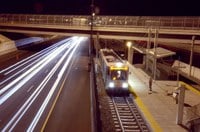Transit & Rail Advisory Committee
 Overview
Overview
The Transit and Rail Advisory Committee (TRAC) was formed in January 2011 to provide advice to the Division and on the needs of the transportation system in Colorado. The Committee is comprised of 14 members with representatives from public and private transit providers, Class I and Shortline railroads, interest groups, transportation planning regions, counties, cities and the general public.
The TRAC will work with DTR staff to develop and promote the Division’s vision, policies, and priorities for transit and rail services in Colorado.
The TRAC now holds a meeting every other month, typically the fourth Thursday of the month beginning at 1 p.m. or 1:30 p.m. If needed, a meeting will be held once a month. Meetings are primarily held virtually with a room reserved for those who attend in-person. The agenda will be posted in the appropriate section as soon as it is finalized prior to the meeting.
Transit & Rail Advisory Committee Vision
"To preserve and enhance the quality of life and the efficient mobility of people and goods, throughout and beyond Colorado, through the development of safe, reliable, environmentally sensitive, economically sound, with the responsibility to plan, develop, operate and integrate transit and rail into the statewide transportation system and customer-responsive transit and rail networks."
Transit & Rail Advisory Committee Vision Values
Accessibility
- To serve the entire state, recognizing mode may change (and transfer locations are important)
- Provide transit opportunities for all populations
- Statewide and nationwide passenger and freight connections
- Community access (local) improvement: connection to regional systems from the start/end point, requires a strong local system to get travelers to the regional system
- Include and expand passenger and freight rail
Mobility
- Provide transit opportunities for all populations (ease of access)
- Seamless connectivity (ease of connections from passenger viewpoint)
- Statewide and nationwide passenger and freight connections
- Reduce auto dependency
- Travel-time, cost, frequency, competitiveness, and reliability (especially competitiveness)
- Integrate regional connectivity in all transportation projects (accommodate other modes in projects)
- Create passenger-friendly environment
Safety
- Ensure a safe and secure system
Economic Development
- Marketing consideration: educating the public about rail vs. truck vs. transit vs. auto
- Preserving potential intermodal hubs and right-of-way (focus on potential)
Economic development and vitality (Transit Oriented Development, impact of short line railroads and passenger rail on economy) - Include and expand passenger and freight rail
Environmental and Resource Conservation
- Economic and energy efficiency (less energy used)
- Reduce auto dependency, as related to fuel consumption and pollutant emissions
- Include and expand passenger and freight rail
Efficiency
- Thoughtful passenger and freight inter-modalism
- Economic and energy efficiency (more people and goods transported per unit of energy used)
System Preservation and Expansion
- Preserving existing infrastructure
- Prepare and protect future infrastructure and right-of-way
- Include and expand passenger and freight rail, with a focus on preservation and allowing expansion when economically feasible
